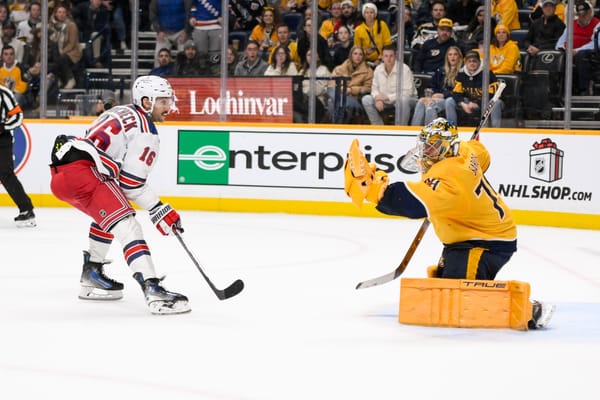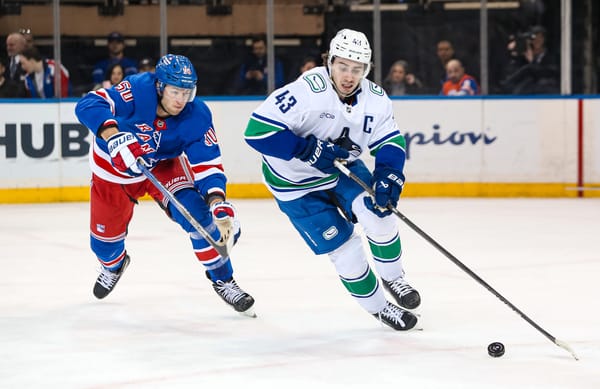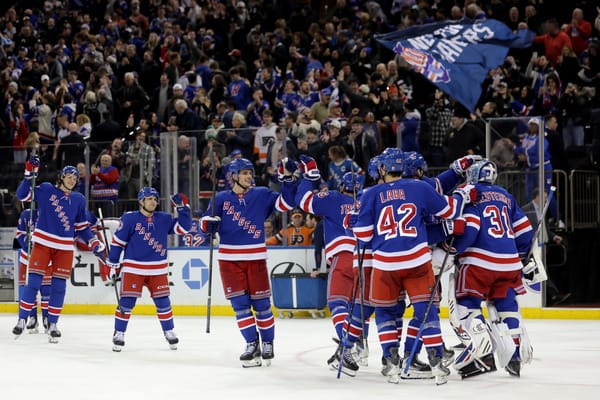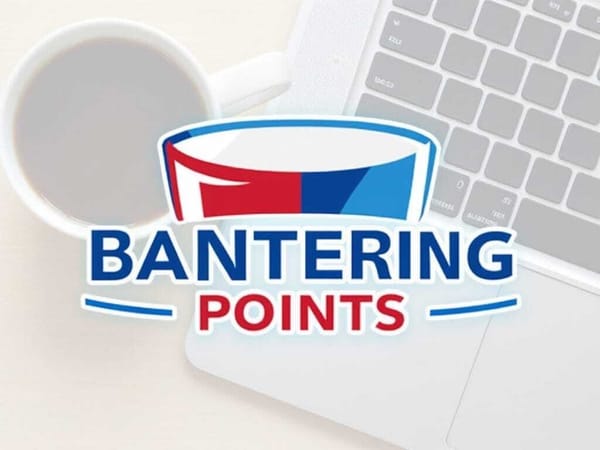The Next Great New York Rangers Third Line
The Traverse City Tournament is well underway, and Adam did a great job of analyzing the play of, in particular, Brett Howden and Filip Chytil. I’m not going to rehash what he said, because he knows prospects better than I do - clicking the above link will tell you all you need to know on that front. One thing that stuck out to me however was the play of Brett Howden, who was on a line with Ty Ronning and Tim Gettinger. All three of those prospects are not quite the bluechip, household name up-and-comers that other teams have, but all three have been impressive in their junior hockey careers and have the chance to become sneaky-good players down the line. It’s probably fair to say that none of these guys will ever be top line talent, but could make names for themselves as bottom-six secondary scorers. In today’s NHL you simply won’t go far without those kind of guys supporting your top scorers, so I don’t mean that in any way as a slight. In fact, I’m pretty excited to see all of them individually work their magic one day in the NHL potentially, and hopefully even as a collective.
That’s where I got this kooky idea in my head, which led me down a statistical rabbit hole that I wanted to share with you all. You see, my favorite Rangers combo outside of the vaunted KZB line we’ll hopefully be seeing more of in the future was anchored by the excellent Derick Brassard, with Mats Zuccarello and Benoit Pouliot on the wings. They were a treat to watch, and reading Adam’s descriptions of Howden, Ronning, and Gettinger’s play and knowing what I know of them (admittedly not much, but enough to know I should be excited about them) had me walking down memory lane with some old friends while imagining what might lay ahead. We know, more or less, that the Rangers are going to look to guys like Vitali Kravtsov and Pavel Buchnevich to be their main offensive threats, but I wanted to do a deep dive and see what that Traverse City line might do in the NHL, and how they might compare to the best third line the Rangers have had in the Henrik Lundqvist era. It all just seemed to fit together so well, and why not do something totally ridiculous to pass the time on a gray Saturday?
To lay down a baseline for what we actually had in the Three Best Friends That Anyone Could Have (Brass, Zucc, and Captain Taco) I figured it’d be best to look at the 2013-2014 campaign, a high point for the Rangers as a team and that line in specific . I’ve combined both playoff and regular season numbers, and will continue to do so throughout this piece, because a goal is a goal, and it seems silly to limit the sample sizes we’ll be working with. In 45 games played together, they had the second highest TOI, playing 540.91 minutes as a unit and scoring 32 goals while taking 17 goals against. Zucc and Pouliot were each 27 years-old that season, while Brass was 26 - this is important as we get down to our comparison and pick apart the numbers for each of the youngsters we’re looking at. As we move on from here though and make our projections, the primary point of reference will be Derick Brassard and his path to the NHL. This is mostly because he, like Howden as described by Adam in the piece linked above, was mostly a finesse player, a center, and the main driver of play on that line (as Howden has been in Traverse City). As a fair warning, there’s going to be a lot of numbers coming up, so if you don’t care to see how the sausage is made feel free to skip to the end where I’ll wrap it all up and serve it with some hot peppers on a roll.
Derick Brassard, very conveniently, is 30 years-old currently, with each of Howden, Ronning, and Gettinger being 20, which means we can just look at some numbers from a solid decade ago to begin painting a picture of what we had and what we might have in the future. All of this is going to be a bit wonkish in that it involves a bunch of math, and a bit wonky (there’s a difference) in that it involves some serious caveats. First, we’re using one player who played center as a barometer for three guys, two of whom play wing. Second, the game has changed significantly both at the junior level and pro level in the past 10 years, with coaching, development, and play style all shifting in a different direction over that time period. Along those lines, although the NHLe coefficients from Manny over at Corsica are pretty great for the present day, they might not be ideal for crunching decade-old numbers, but they’re the best we’ve got. These players all play a different game as well on an idiosyncratic level, most of these things don’t progress perfectly linearly, and so on, so please do take everything I say here with a couple of grains of salt. Still, an imperfect comparison is better than no comparison at all, and it’s all in good fun regardless so why get worked up about the sturdiness of the house we’re about to build? It’s not like we’re actually going to be living in it.
Getting right down to it, in the 2005-2006 season with the Drummondville Voltigeurs of the QMJHL, Derick Brassard had 49 goals in 65 games total. The following season he had 15 goals in 26 games, and the next season he made the jump to professional hockey when he played for the Syracuse Crunch of the AHL and had a brief stint with the Columbus Blue Jackets, the team that drafted him. In those respective leagues he had 19 goals in 55 games and 1 in 17.
Now here’s where the fun starts: what I did was I took the aforementioned NHLe coefficients for each league he played in, multiplied that by goals scored, divided it by games played, and then multiplied it by 82 to get a number representing how many NHL goals those minor league goals were equivalent to. I did that with each of our current prospects as well, but we’ll get to that later. For now, what you need to know is that Brassard had 8.04 equivalent goals for a full 82 game season in 2005-2006, 6.15 in a hypothetical 82 games the following season, and lastly 16.72 NHL equivalent goals in 2007-2008. If that last one seems high keep in mind that the AHL is a significantly better league than the QMJHL (a 0.42 NHLe coefficient compared to a 0.13 NHLe coefficient) and an NHL goal is well, and NHL goal. As a percentage (this’ll be important for both our short term comparison with Howden, Ronning, and Gettinger, as well as the long-term projection we’ll be making at the end) he improved -23.5% from the 05-06 season to the next (which is to say he got worse, which we knew) and then 160% after making the jump from the Q to the AHL/NHL between 06-07 and 07-08. Keep in mind that Brassard was drafted 6th overall when he entered the league and also was putting up boatloads of assists as well, but we’re only going to be looking at goals because the scope of comparing our old third line to the potential third line of the future is just goals.
With Howden, it’s an interesting parallel. He put up 28 goals in 78 games in 15-16, 40 in 65 in 16-17, and 31 in 63 in 17-18. With an NHLe of 0.15 for the WHL, and then stretching everything out over an 82 game season, this all comes out to, respectively, 4.42, 7.57, and 6.05 goals for young Brett. As far as percentage improvement goes, that’s a 71.3 percent gain from the first season to the second, and then a 20.1 percent dip, averaging 25.6 improvement over the three years.
Ronning is the natural goal-scorer among the trio, and his numbers bear that out, but even he has a little dip like Brassard in the middle as far as his stats go - 31 goals in 67 games from 15-16, 25 in 68 from 16-17, and a whopping 62 in 77 for this past season, a huge jump that in terms of NHLe takes him from 5.69 with a smallish drop to 4.52, and then a huge jump to 9.90 NHL goals if he were to play a full season right now in The Show. Percent-wise that’s a drop of -20.6% but a gain of 119% for an average of 49.2%.
Gettinger keeps things a bit tighter as far as his range goes, notching 18 goals in 72 games, 35 in 73, and then 40 in 90 in the three seasons between 2015 and 2018. Due to the fact that he plays in the OHL, there’s a slight bump in the NHLe coefficient used for these calculations - it’s 0.16 instead of 0.15 for the WHL or 0.13 for the QMJHL. All of that comes out to 3.28 goals, 6.29 goals, and 5.83 goals over a regular NHL season, which even though it isn’t quite as impressive as the other two prospects’ is still kind of wild when you consider that Cody McLeod likely won’t break those figures this year, if he does indeed play 82 games (I should hope not). Gettinger’s percent improvement between each of these seasons is 91.7% and then -7.03% for an average of 42.2%.
Now just looking at these numbers quickly before we move on to the really crazy stuff, it seems to me that while none of these guys have quite the wow factor of Brassard, they’re all solid players in their own right. This is part of what makes a third line role so ideal for them - you don’t want players like this out of their depth. Quite the opposite, you need to recognize what you do and don’t have an put them in a position to succeed. Although year to year Howden improved the least on average, we’re also talking about two year-to-years for those purposes, and three seasons overall, meaning the sample size is admittedly small. None of this is gospel, but what I am seeing, and I hope you are too, is that right now, Brett Howden, Ty Ronning, and Tim Gettinger could technically crack an NHL roster, and although they’d be totally out of their depth they’d still manage to put the biscuit in the basket a couple of times. Which brings me to my next point. Derick Brassard was rushed as far as development goes due to excessively high expectations (going 6th overall to a struggling team that wants and needs talent bad will do that to you) and it shows. As we’ll see in just a moment, the swings in his numbers are relatively drastic, and paint a picture of a work in progress that didn’t really begin to come together until he made it to New York. We all know what happened then, so I won’t bore you, but just keep in mind that there’s another wrinkle here in that while Brassard was pushed into the spotlight way too early, the Rangers recognize that the next couple of years aren’t for contending, and will likely let all three of the prospects we’re focusing on here marinate for just a little longer. As a result, they’ll probably taste a little bit better when they come off the grill (please note that I do not under any circumstances endorse cannibalism).
OK, now that we’ve done some preliminary analysis let’s really turn this thing up to 11. Realizing that talented young players usually make massive leaps early on in their development and then taper off as they get older, I figured it’d be better to take a look at how Brassard, our baseline (apologies again that I didn’t do this for Zucc and Pouliot as well, but that would’ve been way crazy), fluctuated between each of his seasons from our initial point of comparison to the summit we really want to reach both for the purposes of this analysis and the hopeful success of our future players: the 2013-14 season. It was a great year, I’m sure you all remember, and while Brass had some excellent seasons in New York otherwise, we’re talking about a collective after all and a fun one to boot. We want Howden, Ronning, and Gettinger to turn into the ZuBraPou of the future ideally, and what we really want to know is if that’s possible. With this average improvement percentage that we’ll squeeze out of Brassard’s goal-scoring numbers between 2005 and 2014, we’re going to calculate how much the Three Nuevos Amigos might improve between now and the time they’re hitting prime scoring age. We’re going right up until they’ll be 26, the same age Brass was when he made it to the Stanley Cup Final with the Rangers (Zucc and Pouliot were each 27, as I mentioned earlier, but close enough).
So Derick Brassard, having scored 8.04 NHL equivalent goals over 82 imaginary games in 05-06, followed up by 6.15 and 16.72 before breaking into the NHL full time, put up the following: 10 goals in 31 games in 08-09, 9 goals in 79 games in 09-10, 17 goals in 74 games in 10-11, 14 goals in 74 games in 11-12, 14 goals in 59 games in 12-13, and 24 goals in 104 games in 13-14. To put everything into 82 game chunks, that’s 26.5, 9.34, 18.8, 15.5, 13.5, and 18.9 goals in those same seasons. Now, just to keep everything transparent, he improved (in positive or negative terms), during each season from 05-06 until 13-14 like so: -23.5%, 160%, 58.5%, -64.8%, 101%, -17.6%, 25.8%, and -3.10%. As a brief aside, you can see why the rap on him was his inconsistency before he got traded to the Rangers - those are some wide swings.
The average there comes out to a 29.5% year-on-year improvement, so let’s pretend that each of Howden, Ronning, and Gettinger improve to that extent from their 15-16 seasons until the same point as Brass and the Legendary Third Line. That would take Howden’s 4.42 NHLe goals in 2015-16 to a 45.8, Ronning’s 5.69 to a whopping 58.9, and Gettinger’s up to 34 from 3.28. That all seems a bit ridiculous, and Brassard’s numbers in the above calculations are bit inflated due to a couple of small sample sizes and bumps, so let’s imagine that they all develop half as well - that’s 40.6 goals for Howden, 52.2 for Ronning, and 30.1 for Gettinger. A third as well as Brass? Chalk up 38.8 for Howden, 50 for Ronning, and 28.8 for Gettinger. I want to drop another huge caveat here: the development of players from junior hockey to their prime years of NHL scoring is rarely linear, and in fact the diminishing returns on these kinds of players, unless they’re truly exceptional, are usually pretty significant. Still, what I mean to point out here is that these three players, if they hit their ceilings, can all be solid scoring threats (and again, to be clear, I know their ceilings are not this high). Whether they actually do hit their ceilings, whether they suffer major injuries, whether they actually even wind up playing together are all major variables. This is just an exercise, all done just for fun, but even then there’s likely a kernel of truth somewhere in here. My hope is that the truth is that there’s a lot of talent and some potential chemistry, but only time will tell.
But we still need to come full circle, and we still need to make a couple of adjustments. You’ve probably been thinking for example, every time I mention the fact that we’re looking at a past and maybe future third line, that well, these guys aren’t playing on their third lines in juniors. It’s true of course that Brassard, Zuccarello, and Pouliot played on average 12.02 minutes together a night, and what’s more is that although it may have seemed like they were a mainstay institution, they were actually only together for 45 games. So that number I brought up in the beginning, the 32 goals for? Well that’s yet another caveat, but luckily we can do something about it.
Those 32 goals for over 45 games at 12.02 minutes on average a night come out to 0.0591 goals per minute, which carried out over 82 games for let’s say 17 minutes a night (just ballparking what a top line gets and/or what Howden, Ronning, and Gettinger are likely getting on their junior teams) comes out to 82.38 goals, which is pretty sweet (Goal-A-Game Line Mk II?). What do the sum totals of those prior three Baby Ranger calculations come out to? In our first scenario, the pure-Brassard development curve, we’ve got 138.7 goals, 122.9 if they develop half as well, and 117.7 if they develop a third as well. Or, put it another way, if you crunch Howden, Ronning, and Gettinger’s NHL equivalent goal totals down into 12.02 minute shifts for just 45 games, you get a total of 53.8 goals in the first development scenario, 47.7 in the half-as-good one, and 45.7 in the one-third-as-good-as-Brassard development curve. That’s about 14 to 21 goals better than the heyday of the Rangers third line the year they almost won a Cup. Yeehaw.
As a post script, I wanted to thank you all for reading about 3100 words of me drawing out some suspect, amateur mathematical modeling here for you all. This was mostly just fun for me that I decided to share with you, a way of getting excited about the future of this Rangers team and emphasizing that there will be new, fun players who will give us great memories down the road. A lot of the narrative surrounding this upcoming Rangers season is doom and gloom, and perhaps that’s on point. Beyond that however, we’ve got a lot of great hockey to watch. These three players in particular, Brett Howden, Ty Ronning, and Tim Gettinger maybe aren’t the marquee names one thinks of when considering a successful rebuild, but they can certainly be part of a very successful Rangers squad for years to come, serving in large part to provide secondary scoring that looks a little bit more like primary scoring and bring the Rangers right back into contention. The point of all of this is that I know, deep down in my bones, whether all this ridiculous math is right or not, there’s bright days ahead of us and that these three youngsters will play a significant role in them. And it wouldn’t be so bad if the math was right either.




